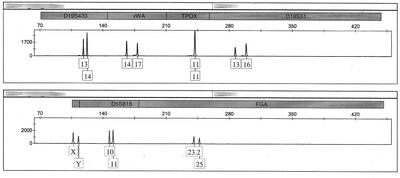A short tandem repeat (STR) in DNA occurs when a pattern of two or more nucleotides are repeated and the repeated sequences are directly adjacent to each other. The pattern can range in length from 2 to 50 base pairs (bp) (for example (CATG)n in a genomic region) and is typically in the non-coding intron region. A short tandem repeat polymorphism (STRP) occurs when homologous STR loci differ in the number of repeats between individuals. By identifying repeats of a specific sequence at specific locations in the genome, it is possible to create a genetic profile of an individual. There are currently over 10,000 published STR sequences in the human genome. STR analysis has become the prevalent analysis method for determining genetic profiles in forensic cases.
Forensic analysis[]

A partial human STR profile obtained using the Applied Biosystems Identifiler kit.
STR analysis is a relatively new technology in the field of forensics, having come into popularity in the mid-to-late 1990s. It is used for the genetic fingerprinting of individuals. The STRs in use today for forensic analysis are all tetra- or penta-nucleotide repeats (4 or 5 repeated nucleotides), as these give a high degree of error-free data while being robust enough to survive degradation in non-ideal conditions. Shorter repeat sequences tend to suffer from artifacts such as PCR stutter and preferential amplification, as well as the fact that several genetic diseases are associated with tri-nucleotide repeats such as Huntington's disease. Longer repeat sequences will suffer more highly from environmental degradation and do not amplify by PCR as well as shorter sequences.[1]
The analysis is performed by extracting nuclear DNA from the cells of a forensic sample of interest, then amplifying specific polymorphic regions of the extracted DNA by means of the polymerase chain reaction. Once these sequences have been amplified, they are resolved either through gel electrophoresis or capillary electrophoresis, which will allow the analyst to determine how many repeats of the STR sequence in question there are. If the DNA was resolved by gel electrophoresis, the DNA can be visualized either by silver staining (not very high resolution, safe, inexpensive), or an intercalating dye such as ethidium bromide (fairly sensitive, moderate health risks, inexpensive), or as most modern forensics labs use, fluorescent dyes (highly sensitive, safe, expensive).[2] Instruments built to resolve STR fragments by capillary electrophoresis also use fluorescent dyes to great effect.[2] It is also used to follow up bone marrow transplant patients.[3] In the United States, 13 core STR loci have been decided upon to be the basis by which an individual genetic profile can be generated.[4]
These profiles are stored on a local, state and national level in DNA databanks such as CODIS. The British data base for STR loci identification is the UK National DNA Database (NDNAD). The British system[5][6] uses 10 loci, rather than the American[7] 13 loci.
Y-STRs (STRs on the Y chromosome) are often used in genealogical DNA testing.
See also[]
- tandem repeat
- variable number tandem repeat
- nucleotide sequences
- Microsatellite
- Minisatellite
- Y-STR
- List of X-STR markers
- List of Y-STR markers
- Genetic fingerprinting
- Single-nucleotide polymorphism (SNP)
- Snpstr
- Strbase
References[]
- ^ Angel Carracedo. "DNA Profiling". http://www.interpol.int/public/Forensic/dna/conference/DNAProfiling01.asp#note41. Retrieved 2010-09-20.
- ^ a b "Technology for Resolving STR Alleles". http://www.cstl.nist.gov/strbase/tech.htm. Retrieved 2010-09-20.
- ^ Antin JH, Childs R, Filipovich AH, et al. (2001). "Establishment of complete and mixed donor chimerism after allogeneic lymphohematopoietic transplantation: recommendations from a workshop at the 2001 Tandem Meetings of the International Bone Marrow Transplant Registry and the American Society of Blood and Marrow Transplantation". Biol. Blood Marrow Transplant. 7 (9): 473–85. DOI:10.1053/bbmt.2001.v7.pm11669214. PMID 11669214.
- ^ John M. Butler, Forensic DNA Typing: Biology, Technology, and Genetics of STR Markers, Second Edition, Academic Press, 2005.
- ^ "The National DNA Database". http://www.parliament.uk/documents/post/postpn258.pdf. Retrieved 2010-09-20.
- ^ "House of Lords Select Committee on Science and Technology Written Evidence". http://www.publications.parliament.uk/pa/ld199900/ldselect/ldsctech/115/115we20.htm. Retrieved 2010-09-20.
- ^ "FBI CODIS Core STR Loci". http://www.cstl.nist.gov/strbase/fbicore.htm. Retrieved 2010-09-20.
External links[]
- EHSTRAFD.org - Earth Human STR Allele Frequencies Database
- Y-DNA Testing Company STR Marker Comparison Chart
- ENFSI STR Population Database
- National Institute of Standards and Technology (NIST) — STR database
- National Institute of Standards and Technology (NIST) — STR Fact Sheets
- MeSH Short+Tandem+Repeats
Template:Repeated sequence
| This page uses content from the English language Wikipedia. The original content was at Short tandem repeat. The list of authors can be seen in the page history. As with this Familypedia wiki, the content of Wikipedia is available under the Creative Commons License. |